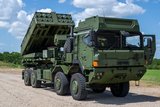Pentagon looks to counter rivals' hypersonic missiles
Even as the Pentagon hustles to ensure that its defences keep pace with North Korea's fast-growing rocket programme, US officials increasingly are turning attention to a new generation of missile threat.
These weapons under development by China and Russia – as well as by the US – can fly at many times the speed of sound and are designed to beat regular anti-missile defence systems.
The hypersonic missiles could change the face of future warfare, as they can switch direction in flight and do not follow a predictable arc like conventional missiles, making them much harder to track and intercept.
Admiral Harry Harris, who heads the US Pacific Command, said: ‘China's hypersonic weapons development outpaces ours... we're falling behind.
‘We need to continue to pursue that and in a most aggressive way in order to ensure that we have the capabilities to both defend against China's hypersonic weapons and to develop our own offensive hypersonic weapons.’
In its proposed $9.9 billion requested budget for 2019, the Missile Defense Agency (MDA) is asking for $120 million to develop hypersonic missile defences, a big increase from the $75 million in fiscal 2018.
MDA Director of Operations Gary Pennett recently said that the potential deployment by America's rivals of hypersonic weapons – which could be launched from planes, ships or submarines and carry either nuclear or conventional payloads – would create a ‘significant’ gap in US sensor and missile interceptor capabilities.
Pennett said: ‘The key challenge to US national security and the security of US friends and allies is the emergence of new threats designed to defeat the existing ballistic missile defence system.’
According to reports in the Japan-based Diplomat magazine, China has developed – and last year tested – a new type of hypersonic missile called the DF-17. The US Office of the Director of National Intelligence this week stated China ‘has tested a hypersonic glide vehicle.’
Russia too is believed to be developing its own hypersonic weapon called the Zircon. According to Russian news agency Tass, it is to go into serial production in 2018.
Though the Pentagon is warning about hypersonics, the US has been developing the technology for years.
The US Air Force says its X-51A Waverider cruise missile, tested in 2012, could travel at speeds faster than Mach 6 (5,800 kilometres per hour).
That is more than 1.6 kilometres a second, and future iterations are expected to go much faster.
Part of the reason China has been able to advance its hypersonic missile programmes is that it is not subject to anti-missile treaties signed between the US and Russia.
The 1987 Intermediate Nuclear Forces (INF) Treaty banned short- and intermediate-range ground-launched missiles.
Harris said: ‘Over 90 percent of China's ground-based missiles would be excluded by INF if they were now in it.’
Still, by far the lion's share of the MDA's budget continues to go towards improving existing missile-defence systems.
Various sensors and radars can track an incoming missile hurtling towards a target, then blast interceptor rockets toward it to pulverise it with kinetic energy.
More from Land Warfare
-
![Hungary set to begin using Hero 400 loitering munitions]()
Hungary set to begin using Hero 400 loitering munitions
Developed by Israel's Uvision and with systems being sold in the thousands to multiple European NATO countries and the US, the Hero family of loitering systems is also in production in the US and Italy, the latter through Rheinmetall.
-
![Lithuanian 1st Division to achieve initial operating capability in 2026]()
Lithuanian 1st Division to achieve initial operating capability in 2026
Lithuania is one of the countries stepping up its defences in the face of the war in Ukraine with a particular focus on its neighbour and Russian ally Belarus, which has been making incursions into Lithuania’s airspace with balloons and drones.
-
Medium knocked out of British Army LMP, with CAVS as heavyweight champion
As the British Army seeks to modernise and consolidate its diverse vehicle fleet, yet another change in direction is underway.























